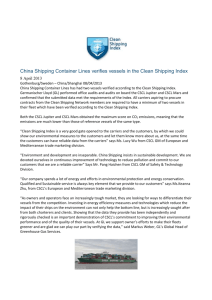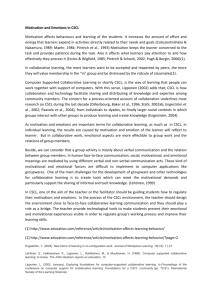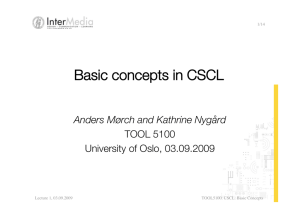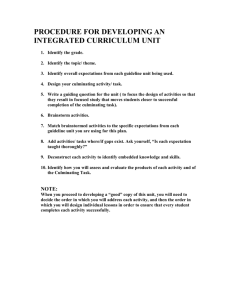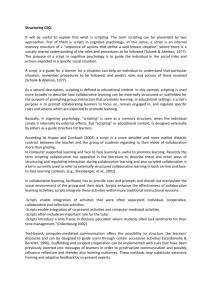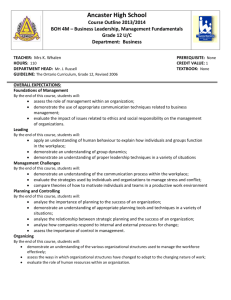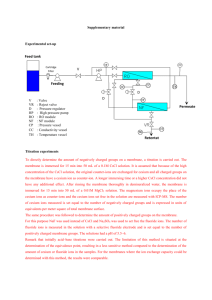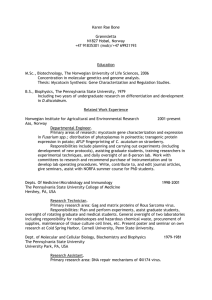Designing Social Infrastructure - ISLS International Society of the
advertisement
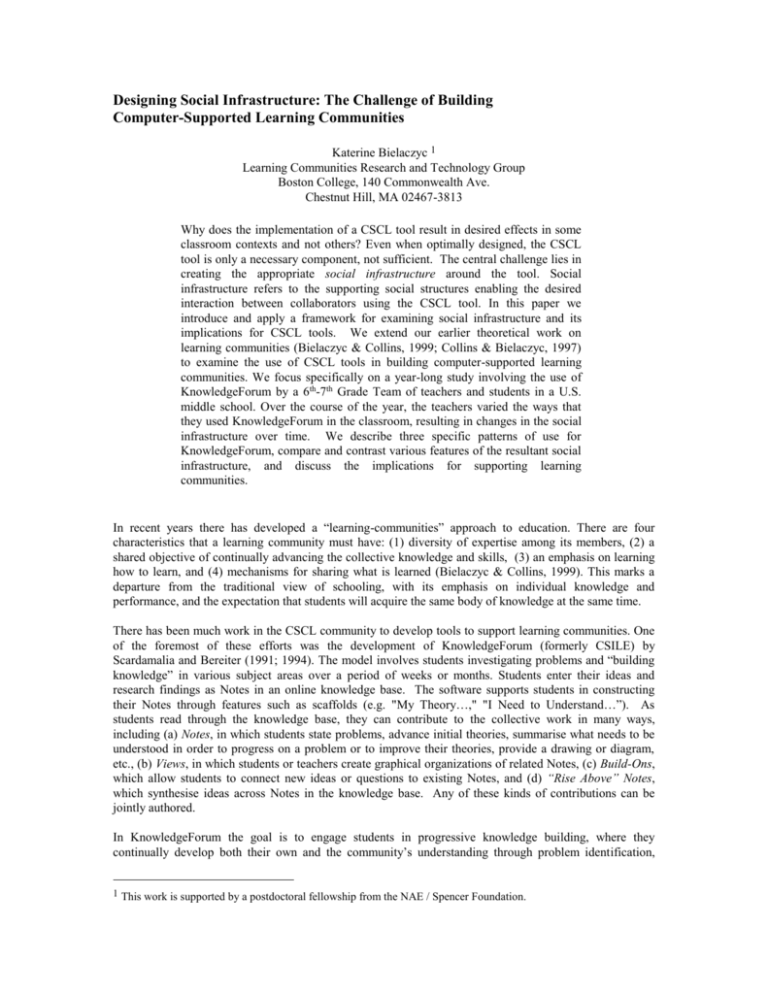
Designing Social Infrastructure: The Challenge of Building Computer-Supported Learning Communities Katerine Bielaczyc 1 Learning Communities Research and Technology Group Boston College, 140 Commonwealth Ave. Chestnut Hill, MA 02467-3813 Why does the implementation of a CSCL tool result in desired effects in some classroom contexts and not others? Even when optimally designed, the CSCL tool is only a necessary component, not sufficient. The central challenge lies in creating the appropriate social infrastructure around the tool. Social infrastructure refers to the supporting social structures enabling the desired interaction between collaborators using the CSCL tool. In this paper we introduce and apply a framework for examining social infrastructure and its implications for CSCL tools. We extend our earlier theoretical work on learning communities (Bielaczyc & Collins, 1999; Collins & Bielaczyc, 1997) to examine the use of CSCL tools in building computer-supported learning communities. We focus specifically on a year-long study involving the use of KnowledgeForum by a 6th-7th Grade Team of teachers and students in a U.S. middle school. Over the course of the year, the teachers varied the ways that they used KnowledgeForum in the classroom, resulting in changes in the social infrastructure over time. We describe three specific patterns of use for KnowledgeForum, compare and contrast various features of the resultant social infrastructure, and discuss the implications for supporting learning communities. In recent years there has developed a “learning-communities” approach to education. There are four characteristics that a learning community must have: (1) diversity of expertise among its members, (2) a shared objective of continually advancing the collective knowledge and skills, (3) an emphasis on learning how to learn, and (4) mechanisms for sharing what is learned (Bielaczyc & Collins, 1999). This marks a departure from the traditional view of schooling, with its emphasis on individual knowledge and performance, and the expectation that students will acquire the same body of knowledge at the same time. There has been much work in the CSCL community to develop tools to support learning communities. One of the foremost of these efforts was the development of KnowledgeForum (formerly CSILE) by Scardamalia and Bereiter (1991; 1994). The model involves students investigating problems and “building knowledge” in various subject areas over a period of weeks or months. Students enter their ideas and research findings as Notes in an online knowledge base. The software supports students in constructing their Notes through features such as scaffolds (e.g. "My Theory…," "I Need to Understand…”). As students read through the knowledge base, they can contribute to the collective work in many ways, including (a) Notes, in which students state problems, advance initial theories, summarise what needs to be understood in order to progress on a problem or to improve their theories, provide a drawing or diagram, etc., (b) Views, in which students or teachers create graphical organizations of related Notes, (c) Build-Ons, which allow students to connect new ideas or questions to existing Notes, and (d) “Rise Above” Notes, which synthesise ideas across Notes in the knowledge base. Any of these kinds of contributions can be jointly authored. In KnowledgeForum the goal is to engage students in progressive knowledge building, where they continually develop both their own and the community’s understanding through problem identification, 1 This work is supported by a postdoctoral fellowship from the NAE / Spencer Foundation. research, and community discourse. However, just as Grossman and her colleagues (in press) emphasise that “community” is not achieved by fiat, community is not achieved through simply implementing a CSCL tool designed to support learning communities either. But what does it take? Why does implementation of a CSCL tool result in the desired effects in some classroom contexts and not others? The real challenge lies in creating the appropriate social infrastructure around the tool. “Social infrastructure” refers to the supporting social structures enabling the desired interaction between collaborators using the CSCL tool. We focus on three levels of social infrastructure: Cultural level: What is the classroom culture in which the CSCL tool lives? What are the overall philosophy and norms established among the teacher(s) and students? Activity level: What are the classroom practices? In what ways do the offline learning activities complement the online activities with the CSCL tool? Tool level: How has the end-user modified the environment? How are the affordances of the CSCL tool actually used in practice? The present paper elaborates the challenges in designing social infrastructure for CSCL tools by focusing on a year-long study of KnowledgeForum with a team of four teachers and their students. Over the course of the year, the teachers varied the ways that the class used KnowledgeForum, resulting in changes in the social infrastructure over time. We describe three specific patterns of use for KnowledgeForum, and compare and contrast various features of the resultant social infrastructure. The Whitman Classrooms Our notions of social infrastructure have been shaped and refined by our work with a team of teachers and students from Whitman Middle School, a small suburban school in the midwest United States. The four teachers on the 6th-7th Grade Team have worked together for several years, and specifically with KnowledgeForum for over 8 years. We chose to work with Whitman because these teachers have developed some of the best uses of KnowledgeForum, sustained over eight years with very little external support. They have been continually experimenting with ways to help their students get the most out of working with KnowledgeForum. In addition, the necessary technical infrastructure is in place, and the CSCL tool is integrated into the daily workings of the classroom. The author worked with the Whitman team of teachers and students during the 98-99 and 99-00 school years. Beginning in the Spring of 1999, classroom visits were made roughly every 6 weeks for a period of 5 days, and data collection included classroom observations, written and online data, and interviews. The present paper focuses on student investigations in three research units over the 99-00 school year. The natural variation across these three units provides the opportunity to examine differences in social infrastructure. Critical variables such as teachers and students, the CSCL tool, and classroom philosophy remain constant, while aspects of the social infrastructure vary across the research units. Because the ordering and the learning by students across the school year is not counter-balanced, we cannot experimentally compare the three units. But by systematically looking at what happened in each case, we can gain valuable insights into the role that social infrastructure plays in the use of CSCL tools in supporting classroom learning communities. Student Investigations Over the 99-00 school year, students used KnowledgeForum to support the following research units: Fall Term: Global Understanding Student investigations focused on countries from around the world. Students studied questions such as: What is the cultural identity of the country? Winter Term: World Religions Student investigations focused on six major world religions: Buddhism, Christianity, Hinduism, Islam, Judaism, and Taoism. Students studied questions such as: What are the basic beliefs set forth in this religion? Spring Term: Astronomy2 Student investigations focused on various aspects of Astronomy, including Planets and Galaxies. Students studied questions such as: Why do the planets revolve around the Sun? Each central research topic was divided into sub-topics (e.g. Global Understanding was divided into countries of the world), and students were matched to sub-topics based on their top three choices. Most students were matched with their first choice. Each research unit lasted roughly 8 weeks. The Whitman Team consisted of four classrooms of roughly 25 students each, with each teacher specialising in one subject matter area: Math, Science, Language Arts, or Personal Development. Students moved from one classroom to the next, and hence one subject matter to another, over the course of a school day. Each day, on a rotating basis, one teacher would host the KnowledgeForum work. When students came to the designated class, they would spend the 50-minute period working on the KnowledgeForum research unit, rather than the usual subject matter curriculum. Students managed their own time during the KnowledgeForum period: conducting their investigations offline or working in the KnowledgeForum database. Students conducted their research using books from the school and public libraries, ordering relevant videos, searching the Internet, and interviewing experts where possible (through interviews out in the community, or bringing specialists into the school). The four classrooms of the Whitman Team had 10 computers each, so all students in the designated KnowledgeForum period were able to work on the database at will. Although students worked on their KnowledgeForum research on a class-by-class basis throughout the day, the learning community that the Whitman Team worked to build spanned across all four classes. The KnowledgeForum database contained the work of all 101 students, and the groups that formed (described below) were based on common interests across all students, rather than within classes of 25 students. Variations occurred in the social infrastructure created around KnowledgeForum over the course of the three units. We examine these variations by looking across the research units in terms of the three levels of social infrastructure. Cultural Level: Classroom Culture of a “Learning Club” One of the central factors of the social infrastructure around a CSCL tool concerns the particular classroom culture in which it resides --- the overall philosophy and norms established among teacher(s) and students. The classroom culture of the Whitman Team was fairly consistent across the two years that the teachers and students were together. The teachers described their main educational objective as fostering a “learning club,” and students referred to themselves as a “learning community,” where the goal was to learn how to be a good learner. The classroom norms included developing individual expertise, serving as learning resources for each other, respecting the ideas of others, and reflecting on the learning process. In working in the KnowledgeForum database, the cultural norms of the classroom translated into creating Notes that not only furthered one’s own knowledge building, but that could be used as resources by other students. Because interaction with others was valued in the culture, as students worked in the KnowledgeForum database they were expected to exchange ideas, build-on to the work of others, share resources, and work to build communal understanding. The databases for all three units showed interaction patterns consistent with such expectations and, as students gave “tours” of the databases during interviews, they pointed out places where other students helped them or where they provided information or resources to others. In surveying students on whether other students helped them to build knowledge in KnowledgeForum, the students responses typically reflected this sense of communal exchange: “because whenever they find something I might need they tell me and they help me when I need to understand 2 In the final unit, students could choose between the areas of Astronomy or the History of Technology. The students divided themselves quite evenly between the two. For simplicity, we focus on the Astronomy database, the History of Technology database had similar characteristics. something.” Further, in interviewing students about interacting with others in the database, students were questioned to the effect of “You can get your own research done without helping others, so why bother?” This question was typically met with an incredulous look, followed by an explanation of how they wouldn’t be a community if they didn’t help each other and of how working together helps one to learn much more than working on one’s own (this explanation was usually given in a patient tone of voice, as if the interviewer didn’t “get it.”). Interestingly, KnowledgeForum itself provided public exemplars that help to strengthen the cultural norms. That is, as students worked in the database, their various contributions became models that were accessible to all students to learn from. Students could read through the database and look at examples of communal knowledge building activities such as argumentation among students with differing viewpoints in multiplyauthored Notes. For example, one student commented that her entries in the KnowledgeForum database changed over time from reading other people’s Notes because (a) it became clear to her that there were expectations to interact with other students, and (b) she saw examples of how people helped each other in their investigations, and began to follow their examples herself. Thus, just as the classroom culture impacts activity in the KnowledgeForum database, in a complementary manner, the database can help reify the norms of the culture. There are two points to be made regarding the classroom culture element of social infrastructure and the ways in which it worked to support student activity in the KnowledgeForum database: The philosophy and norms supporting the KnowledgeForum work were part of the entire school day, not simply part of the 1 hour per day that students worked with KnowledgeForum. The teachers and students consistently worked to build a learning community both with and without KnowledgeForum. Thus, the ways in which students were expected to work with the CSCL environment did not run against the grain of their other learning experiences. It takes time to develop a culture that fosters communal learning. Students entered 6 th grade from a very different culture than the “learning club” that the Whitman Team was trying to develop. Students described how their elementary school years had focused on individualised research, and that the idea of working together to build knowledge was a new concept. Further, as the students entered 6 th grade there was not an existing culture of students to join and become “enculturated” into. The teachers and students had to start from scratch to define and refine their learning community over the two years that they were together. The teachers felt that it was only by their second year together that the class began to truly operate on a communal level. The longer that the students “lived” in the culture, the better able they were to establish and assimilate the relevant philosophy and norms. Activity Level: Classroom Practices of Teaming and Culminating Event Teachers and students engage in a wide variety of learning activities, both online with the CSCL tool and offline in the broader classroom, school, and community contexts. In analysing the classroom practices element of social infrastructure we were interested in the ways in which the offline classroom learning activities support and complement students’ online work with the CSCL tool. There were three major classroom practices that impacted the social infrastructure existing around the use of KnowledgeForum: Teaming: In some units, students were formally grouped into teams meant to collaborate in their investigative efforts. Face-to-Face Meetings: At various points throughout the course of a research unit, students gathered for whole class or team-based discussions regarding their investigations. Culminating Event: At the end of each unit, students shared their learning with the rest of the class in a public activity. We focus here on the issue of Teaming and the Culminating Event: how collaborative groups were formed and operated, and the final activity they worked toward. Unit 1: Global Understanding In Unit 1, individual students investigated individual countries from the continents of Asia, Africa, and Europe. Over time, discussion groups were formed with students from similar regions within a continent (e.g. Northern Africa, Middle East). The Culminating Event for the unit involved each student doing an oral presentation for the class on what they had learned about the country they studied. As students described their work in the KnowledgeForum database for Unit 1, their language indicated that student identity was at the level of an individual country, rather than a regional or continental level: “I’m studying Spain” rather than “We’re studying Europe.” The work in the KnowledgeForum database reflected this individual nature: students tended to author individual Notes detailing what they were learning in their own investigations. When the regional discussion groups were formed (roughly 5 weeks into the unit), members of the group used Build-Ons and multiply-authored Notes to discuss issues relevant to the countries of that region. Although students in the regional discussion groups shared with each other what they were learning about countries in the region, there was no formal expectation to build a communal understanding of what was learned at the level of a continent, or the globe. The incentive to participate in the regional discussions came from classroom norms and personal interests. The Culminating Event in Unit 1 offered no real additional structure or incentive for students to work collectively to pull together what they were learning in their individual investigations. It was possible to create an oral presentation on one’s country without interacting with other students in the class. Unit 2: World Religions In Unit 2, students investigated a particular religion as part of a team. The teams had a Jigsaw structure (Aronson, 1978). Each Religion Team had 5 students, with each student taking on one of 5 unique roles: Anthropologist, Historian, Journalist, Politician, and Theologian. Given the large number of students, there were multiple teams for each religion. Across the Religion Teams, students in similar roles formed “Common-Roles” Teams (e.g. the Historian Team). The Culminating Event for the unit involved a World Peace Conference: a day-long event during which the 101 students met together to examine the commonalities and differences among the religions, and to determine how a treaty of world peace could be forged. The division of roles in each Religion Team was meant to create a structure of interdependency: in order to have a complete understanding of a given religion, an understanding of the areas associated with each role was required. Students were expected to develop expertise in their own areas and then work together with the members of their Religion Team to form a collective understanding. Part of developing the expertise associated with a particular role involved working with other members of one’s Common-Roles Team in order to learn how the focus area played itself out in other religions (e.g. the Historians were meant to work together to examine the historical traces across their various religions). Student identity during the learning activities for this unit was based on membership in multiple teams: “I’m the Historian in our Buddhist Team. We’re learning about Buddhism, and then all of the Historians get together to compare what we’re learning about each of our religions.” The team structures set up an incentive to participate in communal knowledge building activities, where students created Build-Ons and multiply-authored Notes that allowed them to discuss issues at a collective level both within their Religion Teams and across religions as part of their Common-Roles Teams. The Culminating Event of the World Peace Conference required students to come together face-to-face to discuss their own religion, and to build cross-religion understanding and consensus. In preparation for the conference, students within a particular Religion Team worked collectively to create Notes that captured their understanding of the major issues of their religion. Students also read the Notes from other Religion Teams, and participated in discussions in Notes within their Common-Roles Teams, in order to familiarise themselves with issues that would be important in creating a treaty of world peace. Unit 3: Astronomy In Unit 3, students worked in 5-8 person teams to investigate various aspects of Astronomy: Space Exploration, Stars, Planets, Galaxies, Moon, and Sun. There were multiple teams for each topic. Each team determined a set of relevant sub-topics, and each team member investigated a specific sub-topic of interest. For example, members of one of the Planet Teams decided that each member would study a specific planet. The Culminating Event for the unit involved an oral presentation developed and presented by each team to the class. Each topic team worked independently to determine the sub-topics its members would investigate. As in Unit 2, the purpose was to create interdependency among team members. Students were expected to develop expertise in their own sub-topic and then work together to form a collective understanding. However, since each team worked independently to choose the sub-topics, cross-team groups (such as the Common-Roles Teams in Unit 2) were not formed. Student identity during the learning activities for this unit was based on team membership: “I’m investigating Saturn in our Planets team.” The topic team structure set up an incentive to participate in communal knowledge building activities, where students within the same topic team created Build-Ons and multiply-authored Notes that allowed them to discuss issues at a collective level. The oral presentations presented by each team at the end of the unit required students to work together to plan how to present their investigations to the rest of the class. However, the teams varied to the extent to which they created presentations that synthesised the knowledge of the team into a collective understanding. Most teams created presentations in which each member took a turn and presented his or her individual work. Thus, while the Culminating Event of Unit 3 was team-based it was possible to create an oral presentation without engaging in communal knowledge building. Summary In looking at the classroom practices of Teaming and the Culminating Event in the three research units, we see a variation in the social infrastructure created around the KnowledgeForum environment. Teaming fostered a sense of group identity and an incentive to engage in database interactions and communal knowledge building. In Unit 1, the discussion groups did not have the same formality and expectations of communal knowledge building as the team structures in Units 2 and 3. Unit 1 brought together students studying the countries of a continental region to discuss regional issues, whereas Units 2 and 3 set up a construct of “formal co-investigators” into a common topic, with each student charged with an individual responsibility as part of the larger investigation. Students interacted in the KnowledgeForum database in all three units, but Units 2 and 3 reflect a higher level of communal knowledge building. The notion of formal co-investigators created specified resource people to help in one’s own investigations and also provided a sense of responsibility to contribute toward group efforts to build a common understanding. Differences also existed between the team structures of Units 2 and 3, which impacted the database activity differently: in Unit 2, the interaction patterns extended across all of the teams through the interlocking structure of the Jigsaw, while in Unit 3 the interactions tended to stay within the individual topic teams. The structure of the Culminating Event affected the amount of student interdependency required to complete the final activity for a research unit. When students had to depend on understanding the work of their team members in order to accomplish the final activity, they had more reason to read the Notes of others and to engage in communal knowledge building. Tool Level: End-User Variations of Views CSCL tools differ to the extent that they formally allow the end-user to modify their operation. There are two central ways in which end-users can modify a CSCL environment: an environment may have a set of features that have been specifically designed for modification by the end-user (e.g. parameter settings, interface features), or an environment may have a feature with a specified functionality, but an end-user may use the affordances of the feature in unexpected and innovative ways (such stories abound in the design community). In analysing this element of social infrastructure, we were interested in: How did the teachers and students use and modify KnowledgeForum features in order to support a given research unit? Here we focus on an example of the ways in which the Whitman Team used the View feature (the first type of modification). As stated earlier, a View is a screen upon which Notes in the database are displayed. A KnowledgeForum database typically contains multiple Views, indexed by name. On any given View, graphics can be imported or drawn on the background, permitting Notes to be organised geographically on the screen. Our analysis contrasts the use of the View in Unit 1, to its use in Units 2 and 3 (differences also exist between Units 2 and 3 and are discussed in Bielaczyc and Cooney (in preparation), but for the present point, they can be treated similarly). In Unit 1, the Global Understanding database opens to a Welcome View showing a World Map. On the map, on each of the three continents Africa, Asia, and Europe, there are links to associated Views. On each of the continental Views, there are links to Views for each student studying a country of that continent: the Europe View links to 26 student Views, the Asia View links to 50 Views, and the Africa View links to 25 Views. The Welcome View also has links to Views for each regional discussion group. For example, if Livia is studying Ireland, there would be an Ireland-Livia View (see Figure 1). As Livia works in the database, she would spend most of her time in the Ireland-Livia View. The View serves as a personal workspace where Livia would create Notes corresponding to her investigation of Ireland. If Livia wants to learn from or contribute to the work of others, she must visit the individual workspaces of the other students, or the Views for the regional discussion groups. In Units 2 and 3, the views are organised around the Teaming structures discussed earlier. The World Religions database opens to a Welcome View set up as a directory to team Views: links to Views for each Religion Team, and links to Views for each Common-Roles Team; the Astronomy database opens to a Welcome View set up as a directory to team Views for each Astronomy topic. For example, if Livia is the Historian for the Buddhism1 Team, then as she works in the database she would spend most of her time in the Buddhism1 View (see Figure 2) and the Historian View. In the Buddhism1 View, Livia would create individually-authored Notes on the history of Buddhism. The View would also contain Notes by other team members corresponding to their specific investigations. If Livia wants to learn from or contribute to the work of others working in Buddhism, the Notes of the rest of her Buddhism1 Team members are there in the same workspace she works in. Livia can either read and build-on to their individual Notes, or she and other members of the team can come together to discuss issues at a collective level through multiplyauthored Notes. Similarly, as she works in the Historian View, there are multiply-authored Notes that Livia can participate in with other members of her Common-Roles Team. If Livia wants to learn from or contribute to the work of others working outside of her two usual workspaces in the Buddhism1 or Historian Views, she can visit the Views of other teams. Figure 1. The Ireland-Livia View Figure 2. The Buddhism1 View Variations in the use of the View feature across the units impacted the ways that students interacted in the database. The View organisation in Unit 1 resulted in 101 individual Views, which created isolated workspaces for each student. Even though the work of other students were only a mouse click or two away, the individualised nature of the workspaces militated against communal interactions in the database. As students worked in their workspaces, there were no cues regarding the work of other students in the database. In order to become aware of the knowledge building activities of others, students had to visit other Views. In contrast, in Units 2 and 3, the organisational structure of the Views corresponded more closely to the communal knowledge building that was intended: the team-based Views collected together all of the individual Notes of the team members, as well as providing a communal space for housing the multiply-authored Notes created by members of the team. The visual real-estate of the View allowed students to watch the knowledge building activities of others on their team. Further, sharing a common space with one’s team members reified the notion that the team is engaged in common work. Discussion Even if we create CSCL tools with amazing functionality, unless we build social infrastructures that permit them to be used to their full potential, we will not produce effective learning environments for students. Hence, if we are going to help teachers use the new CSCL tools being developed, we must understand how different social arrangements affect tool use. Based on such an understanding, we need to develop a framework and guidelines to support implementation of the tools in classrooms. This paper is a first attempt to specify what such a framework would look like. Our analysis suggests three levels of social infrastructure are important to successful use of CSCL tools: the Cultural Level, the Activity Level, and the Tool Level. At the Cultural Level, issues of classroom philosophy, goals, and norms are central. At the Activity Level, issues of the participant structures and culminating events are central. At the Tool Level, issues concerning the use and adaptation of different tool capabilities are central. While we did not have space to consider them here, other components, such as the teacher’s role, the level of curriculum integration, and the curriculum content, are also critical. Further, while the paper presents each component separately, as we refine our sense of the critical elements of the social infrastructure, we will also need to consider the ways these components interact as a system. References Aronson, E. (1978). The jigsaw classroom. Beverly Hills, CA: Sage. Bielaczyc, K. & Collins, A. (1999) Learning communities in classrooms: A reconceptualization of educational practice. In C. M. Reigeluth (Ed.): Instructional-design theories and models: A new paradigm of instructional theory (pp. 269-292). Mahwah NJ: Lawrence Erlbaum Associates. Bielaczyc, K., & Cooney, M. (in preparation) Social infrastructure: Investigating what makes computer-supported environments successful in the classroom. Collins, A. & Bielaczyc, K. (1997) Dreams of technology-supported learning communities. In Proceedings of the Sixth International Conference on Camputer-Assisted Instruction. Taipei, Taiwan. Herman, J. L. (1994) Evaluating the effects of technology in school reform. In B. Means (Ed.): Technology and education reform (pp.133-168). San Fransisco: Jossey-Bass. Grossman, P., Wineburg, S. & Woolworth, S. (in press). In pursuit of teacher community. Teachers College Record. Scardamalia, M. & Bereiter, C (1991). Higher levels of agency for children in knowledge building: A challenge for the design of new knowledge media. Journal of the Learning Sciences, 1(1), 37-68. Scardamalia, M. & Bereiter, C (1994). Computer support for knowledge-building communities. Journal of the Learning Sciences, 3(3), 265-283.

